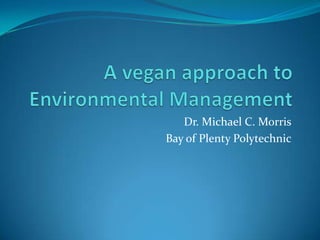Why eat low on the food chain from 2010 cip talk
- 1. A vegan approach to Environmental ManagementDr. Michael C. MorrisBay of Plenty Polytechnic
- 2. DonŌĆÖt Shoot the MessengerHow does the scene from MacBeth show the way we react to news we donŌĆÖt like?Rachel Carson published silent spring in 1962The industry reacted by personal attacks. Rachel Carson is an embittered spinster, or a Lesbian (therefore by implication ignorant)
- 3. The Food and Agriculture Organisation published ŌĆ£livestockŌĆÖs long shadowŌĆØ in 2006. Here is Federated FarmersŌĆÖ intelligent, measured and scientific responseŌĆ£it must be written by a veganŌĆØ (and therefore by implication wrong)
- 4. So vegans are the Lesbians of the 2000s!
- 5. The Elephant in the room
- 6. Environmental degradation has been blamed on...PopulationTransportIndustrial growthCapitalismLack of capitalismCommunismLack of communismGovernment corruptionGodŌĆÖs wrathEtc...
- 7. But what about our ŌĆ£SADŌĆØ diet
- 8. Ecology 101For every step up the food chain, the amount of resources (land, water, fuel, energy etc.) goes up by a factor of tenSo passing food through a cow before eating it is very inefficient
- 10. Agriculture is responsible for 50% of global warming in New Zealand. More than any other industryThis is caused by methane from cow burps (not farts) and nitrous oxide from animal wasteWorldwide, livestock accounts for 18% of all greenhouse gases. More than transport.
- 11. Rats Rats with wings!!!Locusts with tits!
- 12. Source: Eshel and Martin 2006
- 13. Conclusion from Eshel and Martin studyA vegan in a SUV has the same effect as a red-blooded American (or Kiwi) meat eater in a Prius
- 14. Water use1kg of meat requires 10,000 L of water
- 15. Photo: David Hamilton, Waikato University
- 19. Christchurch and the Canterbury PlainsEaster Island
- 21. Illegal Amazonian Deforestation for Soybean production
- 23. Kahikatea forestPhoto: Gilbert van Reenan
- 24. Hauraki PlainsPhoto: Environment Waikato
- 25. Some factsLand clearance for farms is a leading cause of sediment build up and coral reef destructionLand clearance for meat is the leading cause of Amazonian deforestationAlmost all of New ZealandŌĆÖs lowland Kahikatea forest has goneNew Zealand is a biodiversity ŌĆ£hotspotŌĆØImport of Palm kernel is contributing to rain forest destruction in Borneo
- 26. Water pollution
- 29. Some figures90% of Waikato streams are too polluted to swim inFarming in the Waikato contributes more to stream pollution than the Hamilton and Ngarawahia sewage worksA piggery of 16,000 pigs produces as much untreated sewage as a city of 23,000ReidŌĆÖs piggery in Carterton and the Kuku Beach Road piggery have been convicted for pumping raw sewage into the rivers
- 31. Fertiliser ship unloading in TaurangaPhoto: Western Sahara Watch
- 32. Photo: Republic of Nauru
- 33. Some FactsNew Zealand fertiliser use has doubled in the last 10 yearsMost of this finds its way into streamsNauruŌĆÖs fishery has been totally destroyed by phosphate miningPresent phosphate in New Zealand comes from disputed territory in the Western Sahara
- 34. Human rightsLivestock agriculture cannot feed the worldPopulation that could be fed if everyone shared the dietary preferences and food system efficiencies of:Source: Bender, W.H. 1997. How much food will weneed in the 21st Century? Environment. 39: 6-11, 27-28.1 The actual world population in 1990 was 5.3 billion.
- 35. Population that could be fed if everyone shared the dietary preferences and food system efficiencies of:Source: Bender, W.H. 1997. How much food will weneed in the 21st Century? Environment. 39: 6-11, 27-28.1 The actual world population in 1990 was 5.3 billion.
- 36. HealthEating low on the food chain preventsAdult onset diabetes
- 37. Kidney Stones
- 38. Breast prostrate and pancreatic cancerThere are 90 million broiler chickens in New Zealand. Antibiotics are imported by the truck load to prevent these very sick individuals from dying before we are ready to kill themThe source of the swine flu epidemic has been traced to a factory piggery in MexicoBird flu outbreaks start in factory farms
- 39. Animal Welfare
- 40. Layer hens Photo: Wellington Animal Rights Network
- 41. Photo: Open Rescue Coalition
- 42. Broiler chickens (NZ)Photo: Auckland Animal Action
- 44. Pigs
- 47. mulesing
- 48. Vivisection
- 49. Some myths about meatMyth 1: Human canines show humans are designed to eat meatThe truth: Have a look at the skulls in the next slides
- 51. Chimpanzee
- 52. Gorilla
- 53. Homo SapiensBiggest Canine Joke in the Animal Kingdom!
- 54. Myth 2: Meat is necessary for proteinThe truth: Have a look at the protein tables below
- 55. Protein composition and price of eggs and various plant sources. Food composition data comes from the New Zealand Food Composition Tables, 6th Edition (Ministry of Health/Crop and Food Research, 2003). Price data comes from Woolworths online (www.woolworths.co.nz, accessed 23 June 2006).
- 56. Myth 3: Meat eating is what gave humans their brain powerThe truth: Genetic studies show human brain power is more to do with the ability to digest starch. There are several copies of the amylase gene in humans.
- 57. Myth 4: God wants us to eat meat. The truth: Adam and Eve and all the animals were vegan before the fall. Gen. 1:29
- 58. Other rationalisationsOur ancestors ate meatResponse. Our ancestors also lived in caves, spoke in grunts, had poor hygiene and did not own cell phones. Most of us have moved on since then.
- 59. Meat tastes nice.Response: Since when has pleasure been a basis for moral decision making. Maybe children taste nice too!
- 60. Animal eat other animalsResponse. Most animals donŌĆÖt eat other animals. And why should we base our morality on the few that do.
- 61. Conclusion ŌĆō something to think aboutCan you be an environmentalist and continue to...Drive a SUVChop down treesPour pollutants into streamsTake food from the poorOr Eat high on the food chain




























































